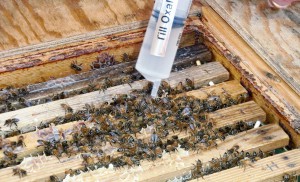Oxalic acid has been used for many years in Europe to kill Varroa mites in bee colonies. Recently it has been approved for use in USA.
When choosing between strategies against this mite it’s good to know all the pros and cons. Not much has been said about the negative aspects of this acid. In 2012 a study was published that hasn’t got much attention among researchers. I understand it’s why Dr Heike Ruff at Würzburgs university in Germany wrote a note about this study in the German bee magazine ADIZ no 2-2015, page 16.
The website Resistantbees.com made a reference to this and also made a summary of the study. http://resistantbees.com/blog/?page_id=2302#dt
If you succeed in using Oxalic acid correct it can help bees survive while they otherwise had died. But experiences from Sweden is that it’s difficult to have a number of years in a row with low winterlosses using Oxalic acid. If it’s only because of not successful tracking of the mite population and treating in summer when needed, not to get to high mite population when it’s time for Oxalic, I don’t know. Or treating when there’s still brood in the colony, quite useless. Or maybe damage has been adding up some years whch results in high losses with intervalls. Obviously there’s more to find out. This study cited below shows that. More beekeepers in Sweden are finding Thymol a better alternative, especially when used in spring (instead of Oxalic in winter) and after the main crop in late summer (instead of pesticide strips).
Best of all though is to work for resistant bees the best we can.
Sublethal effects of oxalic acid on Apis mellifera: changes in behavior and life expectancy. Oxalic acid treatment side effects
To combat the Varroa mite beekeepers can use different veterinary drugs, including organic acids such as formic acid or oxalic acid (OS). So far only the efficacy against the mite and how well the bees could tolerate the acid was evaluated for the approval of the OS. The criterion for how well the bees can withstand and tolerate the Oxalic acid is determined if the bees die (the mortality of the bees). Therefore the recommendation for treatment for Central Europe is to treat once in the broodfree time in late autumn with 3.5% sodium dihydrate OS. Higher concentrations or multiple treatments lead to high loss of bees. A study now shows that the OS-treatment, despite correct application can have harmful effects on bees. The acid affects both the performance and behavior. Treated workers neglected the brood and were inactive. Learning and memory performance for fragrances were reduced. Even the life of the bees were shortened. In addition, the acid can damage the digestive tract of the bee. Also, the bees clean frequently. Whether it is the desire of the bee, to get rid of adhering acid crystals on the body, or is a symptom of poisoning is unclear. Obviously, however, such weakened bees cannot contribute to the health of the colony. The exact effects of the OS are not known to the researchers. Further studies will show whether the effects of acid are caused by nerve damage (neurotoxicity).
The results of the study showed
- That the treatment with OA led to a reduced lifespan.
- That treated bees showed an increased self-grooming, a superior tendency to inactivity and decreased nursing behaviour….The increased self-grooming of the treated workers could be caused by the detected residues of OA on bee surface.
- Treatment with a 3.5% solution of oxalic acid dehydrate (OA), corresponding to the dosage of 175 μg/bee, causes sublethal effects on A. mellifera. The decreased activity and nursing as well as the reduced lifespan of treated bees are aspects for a permanent damage due to the treatment with OA.
- A decreased activity was also noticed in other studies where bees were numb for several hours (24–48 h) post application of 50 mL 4.2% oxalic acid per colony (Bacandritsos et al. 2007). Similar effects are known from bees treated with formic acid. Due to the fact that the animals did not recover from their immobility, permanent neurotoxic damage was assumed (Bolli et al. 1993). Concerning OA treatment comparable damage may have caused the decreased tasks performance in the colony, including nursing.
- OA treatment affects the general condition of bee colonies: the workers’ performance is restrained due to the changes in behaviour, the decreased nursing of brood can lead to a lack of healthy and vital workers and the decreased lifespan could modify demographic alterations in colony age structure. Under the suggestion, that the treatment will cause damage of the digestive organs, such bees would be weaker and less vital. This could influence the general state of health of whole colonies.
References:
- Schneider, S., Eisenhardt, D., RADEMACHER, E., Sublethal effects of oxalic acid on Apis mellifera (Hymenoptera: Apidae): changes in behaviour and longevity, Apidologie, Springer Verlag (Germany), 2012, 43 (2), sid.218-225. https://hal.archives-ouvertes.fr/hal-01003525/document
- Ruff, Heike, Oxalsäurebehandlung mit Nebenwirkungen, ADIZ 2015; 70 (2), p.16.
